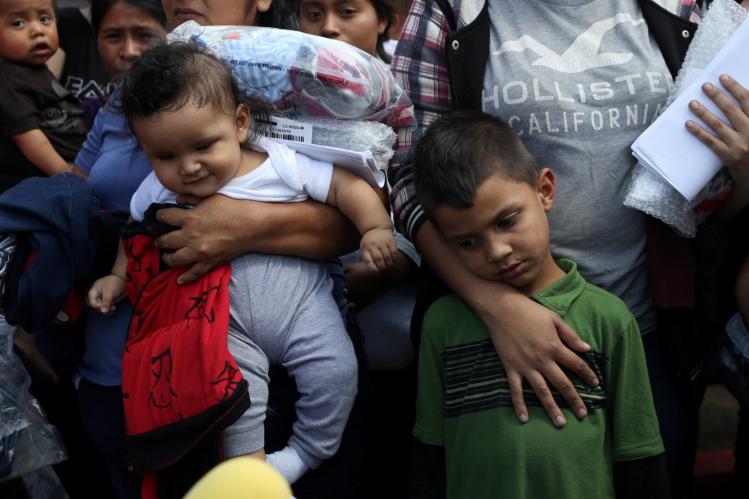
Now that some 191 countries have agreed on the text of the United Nations’ first compact on migration, it’s clearer than ever that the mass-incarceration approach the United States has used to thwart undocumented immigrants fails to meet global standards for human rights.
The text of the Global Compact for Migration was completed on July 13 after six sessions of international negotiation conducted over the past two years, a time when many countries have been engulfed in controversy over immigration. This makes it somewhat remarkable that any sort of consensus was reached. The process isn’t done, though; the next step is a vote on formal adoption, to be held in December at a conference in Marrakesh, Morocco. Hungary has dropped out, and others may dissent as well.
President Donald Trump withdrew U.S. participation last Dec. 2 on grounds that the framework for the negotiations “contains numerous provisions that are inconsistent with U.S. immigration policy and the Trump Administration’s immigration principles,” as the State Department announced. U.S. Ambassador Nikki Haley presented this as a badge of honor, arguing that the global compact would infringe on American sovereignty.
That’s not true, since the Global Compact for Migration bills itself as no more than a “non-legally binding, cooperative framework.” It is true, though, that it creates human-rights commitments that conflict with the accelerating trend in the United States to treat undocumented immigrants as criminals.
“Use immigration detention only as a last resort and work towards alternatives,” one of the compact’s twenty-three objectives states. Detention should last “for the shortest possible period of time,” it says, and signatories “further commit to prioritize non-custodial alternatives to detention that are in line with international law.” The agreement adds that “immigration detention is not promoted as a deterrent” to migration.
The Trump administration’s so-called “zero tolerance” policy runs afoul of that, and so does much of U.S. immigration enforcement policy since Congress passed laws in 1996 that led to mass, open-ended incarceration of undocumented immigrants—even hundreds of thousands who wind up being permitted to remain in the country legally. It’s obvious that detention is a tool federal authorities use to discourage immigrants from pursuing asylum and other legal solutions. Detained immigrants are 2,600 times more likely to depart the U.S. “voluntarily” than those who are not jailed pending the result of their immigration case.
The Global Compact process started on an upbeat note in 2016 with UN General Assembly adoption of what is called the New York Declaration for Refugees and Migrants, the framework for the negotiations that followed. The Obama administration signed on for the United States to take part.
But in short order, Trump was elected president on an anti-immigrant platform and growing anger against immigration had an increasingly dramatic impact on the European Union and its member nations. Trump’s withdrawal notwithstanding, that shift seems to have had an impact on the negotiations, somewhat tempering the grand aims announced in the New York Declaration.
The Global Compact is hardly radical. While explicit in protecting national sovereignty, it waffles on protection of immigrant children, only going so far as to call for “working to end the practice of child detention.”
The Vatican and Catholic non-governmental organizations were actively engaged in the negotiations in behalf of immigrants. There was mixed reaction to the results. Franciscans International, an NGO that represents the Franciscan orders, said that in some ways, the Global Compact for Migration loses ground by adopting lower standards than those already existing in some countries. Marina El Khoury, the organization’s UN representative, said in a statement:
The final text of the Compact is far from what we fought to achieve. We have ended up with a text that practically reinforces a differentiation between regular and irregular migrants, limiting the access of the latter to public services. The failure to address and prohibit the criminalization of migrants will continue to cause the harm we are all witnessing now around the world. We also lost several essential human rights protections throughout the rounds of negotiation; the call to end the practice of exploitative employer-tied visas disappeared; and the realization of the right to nationality was considerably undermined.
Archbishop Bernardito Auza, the papal nuncio at the United Nations, was upbeat. He said the agreement will be a helpful reference point. “This Global Compact will make it more difficult for anyone—States, civil society or anyone of us—to be unaware of the challenges that people on the move face and to fail to meet our shared responsibilities towards them, in particular toward those most in need of our solidarity,” he said.
Archbishop Auza noted remarks Pope Francis made during a homily in St. Peter’s Basilica on July 6, when he said that “before the challenges of contemporary movements of migration, the only reasonable response is one of solidarity and mercy. A response less concerned with calculations, than with the need for an equitable distribution of responsibilities.” We are a long way off from that.


